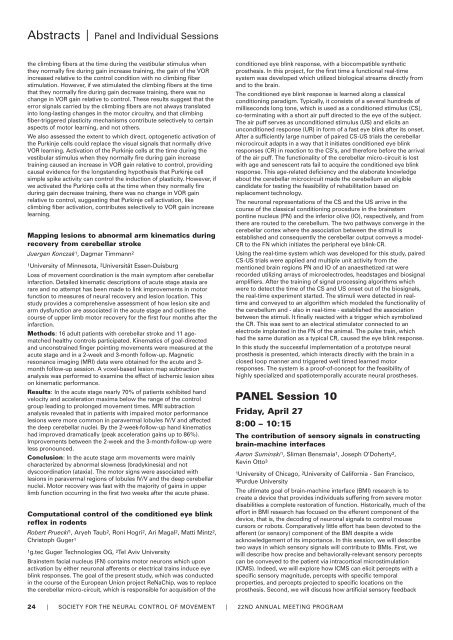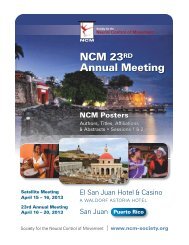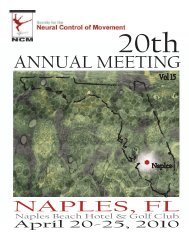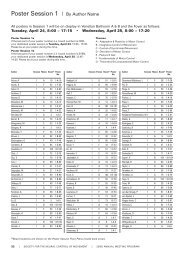2012 Program - Society for the Neural Control of Movement
2012 Program - Society for the Neural Control of Movement
2012 Program - Society for the Neural Control of Movement
You also want an ePaper? Increase the reach of your titles
YUMPU automatically turns print PDFs into web optimized ePapers that Google loves.
Abstracts | Panel and Individual Sessions<br />
<strong>the</strong> climbing fibers at <strong>the</strong> time during <strong>the</strong> vestibular stimulus when<br />
<strong>the</strong>y normally fire during gain increase training, <strong>the</strong> gain <strong>of</strong> <strong>the</strong> VOR<br />
increased relative to <strong>the</strong> control condition with no climbing fiber<br />
stimulation. However, if we stimulated <strong>the</strong> climbing fibers at <strong>the</strong> time<br />
that <strong>the</strong>y normally fire during gain decrease training, <strong>the</strong>re was no<br />
change in VOR gain relative to control. These results suggest that <strong>the</strong><br />
error signals carried by <strong>the</strong> climbing fibers are not always translated<br />
into long-lasting changes in <strong>the</strong> motor circuitry, and that climbing<br />
fiber-triggered plasticity mechanisms contribute selectively to certain<br />
aspects <strong>of</strong> motor learning, and not o<strong>the</strong>rs.<br />
We also assessed <strong>the</strong> extent to which direct, optogenetic activation <strong>of</strong><br />
<strong>the</strong> Purkinje cells could replace <strong>the</strong> visual signals that normally drive<br />
VOR learning. Activation <strong>of</strong> <strong>the</strong> Purkinje cells at <strong>the</strong> time during <strong>the</strong><br />
vestibular stimulus when <strong>the</strong>y normally fire during gain increase<br />
training caused an increase in VOR gain relative to control, providing<br />
causal evidence <strong>for</strong> <strong>the</strong> longstanding hypo<strong>the</strong>sis that Purkinje cell<br />
simple spike activity can control <strong>the</strong> induction <strong>of</strong> plasticity. However, if<br />
we activated <strong>the</strong> Purkinje cells at <strong>the</strong> time when <strong>the</strong>y normally fire<br />
during gain decrease training, <strong>the</strong>re was no change in VOR gain<br />
relative to control, suggesting that Purkinje cell activation, like<br />
climbing fiber activation, contributes selectively to VOR gain increase<br />
learning.<br />
Mapping lesions to abnormal arm kinematics during<br />
recovery from cerebellar stroke<br />
Juergen Konczak1, Dagmar Timmann2 1University <strong>of</strong> Minnesota, 2Universität Essen-Duisburg<br />
Loss <strong>of</strong> movement coordination is <strong>the</strong> main symptom after cerebellar<br />
infarction. Detailed kinematic descriptions <strong>of</strong> acute stage ataxia are<br />
rare and no attempt has been made to link improvements in motor<br />
function to measures <strong>of</strong> neural recovery and lesion location. This<br />
study provides a comprehensive assessment <strong>of</strong> how lesion site and<br />
arm dysfunction are associated in <strong>the</strong> acute stage and outlines <strong>the</strong><br />
course <strong>of</strong> upper limb motor recovery <strong>for</strong> <strong>the</strong> first four months after <strong>the</strong><br />
infarction.<br />
Methods: 16 adult patients with cerebellar stroke and 11 agematched<br />
healthy controls participated. Kinematics <strong>of</strong> goal-directed<br />
and unconstrained finger pointing movements were measured at <strong>the</strong><br />
acute stage and in a 2-week and 3-month follow-up. Magnetic<br />
resonance imaging (MRI) data were obtained <strong>for</strong> <strong>the</strong> acute and 3month<br />
follow-up session. A voxel-based lesion map subtraction<br />
analysis was per<strong>for</strong>med to examine <strong>the</strong> effect <strong>of</strong> ischemic lesion sites<br />
on kinematic per<strong>for</strong>mance.<br />
Results: In <strong>the</strong> acute stage nearly 70% <strong>of</strong> patients exhibited hand<br />
velocity and acceleration maxima below <strong>the</strong> range <strong>of</strong> <strong>the</strong> control<br />
group leading to prolonged movement times. MRI subtraction<br />
analysis revealed that in patients with impaired motor per<strong>for</strong>mance<br />
lesions were more common in paravermal lobules IV/V and affected<br />
<strong>the</strong> deep cerebellar nuclei. By <strong>the</strong> 2-week-follow-up hand kinematics<br />
had improved dramatically (peak acceleration gains up to 86%).<br />
Improvements between <strong>the</strong> 2-week and <strong>the</strong> 3-month-follow-up were<br />
less pronounced.<br />
Conclusion: In <strong>the</strong> acute stage arm movements were mainly<br />
characterized by abnormal slowness (bradykinesia) and not<br />
dyscoordination (ataxia). The motor signs were associated with<br />
lesions in paravermal regions <strong>of</strong> lobules IV/V and <strong>the</strong> deep cerebellar<br />
nuclei. Motor recovery was fast with <strong>the</strong> majority <strong>of</strong> gains in upper<br />
limb function occurring in <strong>the</strong> first two weeks after <strong>the</strong> acute phase.<br />
Computational control <strong>of</strong> <strong>the</strong> conditioned eye blink<br />
reflex in rodents<br />
Robert Prueckl1, Aryeh Taub2, Roni Hogri2, Ari Magal2, Matti Mintz2, Christoph Guger1 1g.tec Guger Technologies OG, 2Tel Aviv University<br />
Brainstem facial nucleus (FN) contains motor neurons which upon<br />
activation by ei<strong>the</strong>r neuronal afferents or electrical trains induce eye<br />
blink responses. The goal <strong>of</strong> <strong>the</strong> present study, which was conducted<br />
in <strong>the</strong> course <strong>of</strong> <strong>the</strong> European Union project ReNaChip, was to replace<br />
<strong>the</strong> cerebellar micro-circuit, which is responsible <strong>for</strong> acquisition <strong>of</strong> <strong>the</strong><br />
conditioned eye blink response, with a biocompatible syn<strong>the</strong>tic<br />
pros<strong>the</strong>sis. In this project, <strong>for</strong> <strong>the</strong> first time a functional real-time<br />
system was developed which utilized biological streams directly from<br />
and to <strong>the</strong> brain.<br />
The conditioned eye blink response is learned along a classical<br />
conditioning paradigm. Typically, it consists <strong>of</strong> a several hundreds <strong>of</strong><br />
milliseconds long tone, which is used as a conditioned stimulus (CS),<br />
co-terminating with a short air puff directed to <strong>the</strong> eye <strong>of</strong> <strong>the</strong> subject.<br />
The air puff serves as unconditioned stimulus (US) and elicits an<br />
unconditioned response (UR) in <strong>for</strong>m <strong>of</strong> a fast eye blink after its onset.<br />
After a sufficiently large number <strong>of</strong> paired CS-US trials <strong>the</strong> cerebellar<br />
microcircuit adapts in a way that it initiates conditioned eye blink<br />
responses (CR) in reaction to <strong>the</strong> CS’s, and <strong>the</strong>re<strong>for</strong>e be<strong>for</strong>e <strong>the</strong> arrival<br />
<strong>of</strong> <strong>the</strong> air puff. The functionality <strong>of</strong> <strong>the</strong> cerebellar micro-circuit is lost<br />
with age and senescent rats fail to acquire <strong>the</strong> conditioned eye blink<br />
response. This age-related deficiency and <strong>the</strong> elaborate knowledge<br />
about <strong>the</strong> cerebellar microcircuit made <strong>the</strong> cerebellum an eligible<br />
candidate <strong>for</strong> testing <strong>the</strong> feasibility <strong>of</strong> rehabilitation based on<br />
replacement technology.<br />
The neuronal representations <strong>of</strong> <strong>the</strong> CS and <strong>the</strong> US arrive in <strong>the</strong><br />
course <strong>of</strong> <strong>the</strong> classical conditioning procedure in <strong>the</strong> brainstem<br />
pontine nucleus (PN) and <strong>the</strong> inferior olive (IO), respectively, and from<br />
<strong>the</strong>re are routed to <strong>the</strong> cerebellum. The two pathways converge in <strong>the</strong><br />
cerebellar cortex where <strong>the</strong> association between <strong>the</strong> stimuli is<br />
established and consequently <strong>the</strong> cerebellar output conveys a model-<br />
CR to <strong>the</strong> FN which initiates <strong>the</strong> peripheral eye blink-CR.<br />
Using <strong>the</strong> real-time system which was developed <strong>for</strong> this study, paired<br />
CS-US trials were applied and multiple unit activity from <strong>the</strong><br />
mentioned brain regions PN and IO <strong>of</strong> an anaes<strong>the</strong>tized rat were<br />
recorded utilizing arrays <strong>of</strong> microelectrodes, headstages and biosignal<br />
amplifiers. After <strong>the</strong> training <strong>of</strong> signal processing algorithms which<br />
were to detect <strong>the</strong> time <strong>of</strong> <strong>the</strong> CS and US onset out <strong>of</strong> <strong>the</strong> biosignals,<br />
<strong>the</strong> real-time experiment started. The stimuli were detected in realtime<br />
and conveyed to an algorithm which modeled <strong>the</strong> functionality <strong>of</strong><br />
<strong>the</strong> cerebellum and - also in real-time - established <strong>the</strong> association<br />
between <strong>the</strong> stimuli. It finally reacted with a trigger which symbolized<br />
<strong>the</strong> CR. This was sent to an electrical stimulator connected to an<br />
electrode implanted in <strong>the</strong> FN <strong>of</strong> <strong>the</strong> animal. The pulse train, which<br />
had <strong>the</strong> same duration as a typical CR, caused <strong>the</strong> eye blink response.<br />
In this study <strong>the</strong> successful implementation <strong>of</strong> a prototype neural<br />
pros<strong>the</strong>sis is presented, which interacts directly with <strong>the</strong> brain in a<br />
closed loop manner and triggered well timed learned motor<br />
responses. The system is a pro<strong>of</strong>-<strong>of</strong>-concept <strong>for</strong> <strong>the</strong> feasibility <strong>of</strong><br />
highly specialized and spatiotemporally accurate neural pros<strong>the</strong>ses.<br />
PANEL Session 10<br />
Friday, April 27<br />
8:00 – 10:15<br />
The contribution <strong>of</strong> sensory signals in constructing<br />
brain-machine interfaces<br />
Aaron Suminski1, Sliman Bensmaia1, Joseph O’Doherty2, Kevin Otto3 1University <strong>of</strong> Chicago, 2University <strong>of</strong> Cali<strong>for</strong>nia - San Francisco,<br />
3Purdue University<br />
The ultimate goal <strong>of</strong> brain-machine interface (BMI) research is to<br />
create a device that provides individuals suffering from severe motor<br />
disabilities a complete restoration <strong>of</strong> function. Historically, much <strong>of</strong> <strong>the</strong><br />
ef<strong>for</strong>t in BMI research has focused on <strong>the</strong> efferent component <strong>of</strong> <strong>the</strong><br />
device, that is, <strong>the</strong> decoding <strong>of</strong> neuronal signals to control mouse<br />
cursors or robots. Comparatively little ef<strong>for</strong>t has been devoted to <strong>the</strong><br />
afferent (or sensory) component <strong>of</strong> <strong>the</strong> BMI despite a wide<br />
acknowledgement <strong>of</strong> its importance. In this session, we will describe<br />
two ways in which sensory signals will contribute to BMIs. First, we<br />
will describe how precise and behaviorally-relevant sensory percepts<br />
can be conveyed to <strong>the</strong> patient via intracortical microstimulation<br />
(ICMS). Indeed, we will explore how ICMS can elicit percepts with a<br />
specific sensory magnitude, percepts with specific temporal<br />
properties, and percepts projected to specific locations on <strong>the</strong><br />
pros<strong>the</strong>sis. Second, we will discuss how artificial sensory feedback<br />
24 | SOCIETY FOR THE NEURAL CONTROL OF MOVEMENT | 22ND ANNUAL MEETING PROGRAM










